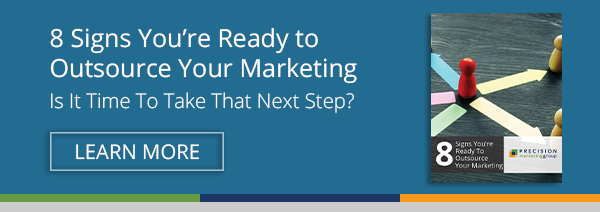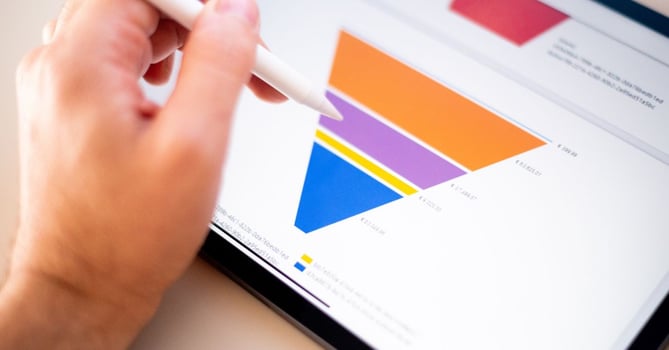In the last few decades, demand for just about anything "as a service" has exploded. Along with the rise in consumer demand, SaaS companies crowd the content marketplace, fight for authority in search engines, and evolve their marketing strategies in hopes of cutting through the noise.
Needless to say, the competition for loyal customers is fierce. So where should SaaS executives focus their efforts?
Before getting mired down in creative options or an all-too-tech-heavy marketing stack, start by taking a good look at your marketing funnel.
In this article, we'll cover what you need to know about the SaaS marketing funnel: how it compares to the sales funnel, the different stages of the funnel, and marketing strategies at each stage. You'll also learn how and why some SaaS companies are missing out on their biggest opportunities in SaaS marketing. Let's get started.
Marketing Funnel vs. Sales Funnel: What’s the Difference?
Outside of gas stations, nowhere is the word “funnel” muttered as much as it is in marketing. As a SaaS business owner, you too are no stranger to your "funnel" -- and you're evaluating it regularly to gauge opportunities and project sales. But what's the difference between the marketing funnel and the sales funnel?
A marketing funnel is intended to mean the path a prospect journeys down while (hopefully) becoming a customer. Whether it’s using a simple social media profile or a digital billboard in Times Square, marketing teams try to fill the top of the funnel through advertising and other awareness campaigns. Your company’s funnel is the process in which someone goes from first seeing your ad to becoming a loyal customer.
Though the concepts of a marketing funnel and a sales funnel are often conflated and the terms used interchangeably, the sales funnel can be considered the latter half of the marketing funnel. The sales funnel is where your prospects decide to buy or not and whether to buy additional products or services from your SaaS organization. Prospects come in at the top (in the marketing funnel) and finalize contracts and sign on the dotted line at the bottom (in the sales funnel).
Unlike regular funnels, everything you put in at the top doesn’t come out of the bottom of the SaaS funnel. Many leads and prospects are lost along the way. Here is where marketing plays a critical role.
Customer Lifecycle and Marketing Funnel Stages
When breaking down the customer lifecycle, let’s start where most companies spend a lot of time – at the top of the funnel, in the Awareness phase.
In this stage, your prospect has never heard of your SaaS company. The things your organization is probably doing to try to generate visibility and attract these new prospects likely include:
- Publishing articles and blog posts
- Creating social media content
- Public Relations initiatives (press releases and reporter networking)
The inherent challenge in this stage is that you will be talking to many people who are not primed to buy your product or service -- and may not even need it. You’re casting a wide net, and not everything you catch will be the right kind of fish -– or even a fish at all!
Prospects in the next funnel stage – the Interest phase – know they have a problem. The challenge, in this stage, is convincing potential customers that your SaaS solution is the solution to that problem. Here, your prospects might already be considering your competitors.
To win prospects over in this stage, you may consider publishing case studies on past successes, or “how to” articles explaining how a particular solution works. This stage is all about supplying information that answers typical buyer questions. It's also about differentiating your business -- read on for more marketing strategies for this phase.
In the Consideration phase, you may have already earned a bit of trust from your prospect. Perhaps prospects are trying to decide between you and your primary competitor. Your SaaS company should consider publishing product comparisons, thought leadership material, product overviews, and customer reviews.
Things get really serious in the last phase of the marketing funnel, the Evaluation phase. Here, your prospect is on the verge of buying, and this stage is rife with dangers that could lead to a missed opportunity.
You might try bundling promotions or exclusive pricing into your pitch at this stage. Or, you may want to lean on additional case studies showing success in related industries, create specialized sales presentations, or provide product guides and videos that showcase how functional and effective your product is.
Where SaaS Marketing Strategies Often Go Wrong
What many companies miss in all their efforts throughout the funnel stages is an intense focus on customers.
What touchpoints will people have with your company and brand after they become customers? Effective training content, knowledge bases, resource centers, support videos, and FAQs that help your customers get full leverage of your product are critically important and often overlooked.
These initiatives represent essential strategies within the SaaS sales funnel. While they come after the marketing funnel, they are vital to a “land and expand” approach, where your company starts with a small deal and forms a strong relationship with a new customer.
Showing the value your company provides early in the customer relationship is where many SaaS companies struggle, given all the other early-stage priorities that call for attention.
Refocusing Your SaaS Marketing Funnel
So why do leads slough off? Oftentimes, it is because SaaS companies tend to focus on one part of the funnel while neglecting others. If your organization is burning through cash doing paid social media ads, expensive Pay Per Click campaigns, trade articles, and other “top of funnel” strategies meant to introduce new prospects to your SaaS product, there could be a better way.
It’s not that these marketing activities aren’t necessary or not needed. It’s that many SaaS marketing organizations get bogged down in these activities when they should be thinking more comprehensively. Simply put, if one area of the funnel is overcrowded, nothing will get through.
For example, many SaaS organizations are overly focused on attracting new leads when their time and budget are better spent on reducing churn. In a recurring revenue model, where customer retention is at the core of profitability and growth, switching your focus from attraction to retention is crucial to your SaaS company's long-term success. This concept falls under the umbrella of Customer Success -- don't miss PMG's Ultimate Guide to Harnessing Customer Success.
The Role of B2B SaaS Metrics
You are off and running. Your marketing and sales teams are churning out content, optimizing your website, having great creative in-market, and executing against your SEO strategy. How do you know if it’s all working as it should? Here is where your metrics play a major role.
The reality is that SaaS metrics will need to be tracked depending on your target outcomes. Customer churn rate, as mentioned, is hugely important. Other key SaaS metrics include Monthly Recurring Revenue (MRR) and Customer Acquisition Cost (CAC). For a complete list, be sure to check out our Guide to SaaS Metrics.
It probably goes without saying that metrics should never be taken at face value. Be sure you have a dedicated resource who is able to understand and respond to trends that you're seeing with your metrics.
For example, if you have lost a high number of customers within a certain timeframe, be sure you understand the "why" behind that churn. What will help your customers stick? New SaaS features or product upgrades? Or do you simply need to strengthen your marketing approach with some customer acquisition strategies? The tendency for many SaaS leaders is to apply a product-minded approach over a customer-first approach -- which may not give you the results you're looking for.
For more great examples, this article highlights some of the ways large SaaS companies focus on the customer experience as a way of impressing customers after the sale.
If you are ready to get started with a new SaaS marketing approach -- one that optimizes your marketing funnel at every stage -- don’t hesitate to reach out to us at any time. Not sure outsourcing is the way to go? Our guide below can help you decide!











